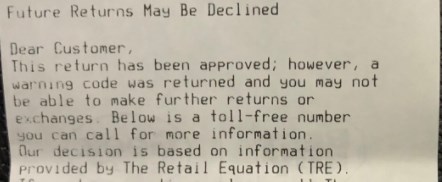
Retailers and other businesses have gotten really good at tracking you and your activities and if in the process some legitimate customers get hurt, they’re mostly pretty OK with that.
Last November, for example, I bought a six-pack of tickets at the invitation of the Cleveland Indians for the coming season, knowing I wouldn’t be able to use them all. I bought six last year and didn’t get to any of the games so took advantage of the Indians ticket account website option to sell them on StubHub, the official reseller of Major League Baseball.
And that’s why two weeks ago, the Indians sent me my money back and revoked the tickets. To their algorithms, I’m not a dedicated fan 800 miles away hedging an unusual support for the team, I could be a ticket scalper from Parma, Ohio, and the team is still reeling from game seven of 2016 World Series in which season ticket holders sold their tickets to Cubs fans.
The next time I buy tickets and don’t use them, a team official said, the team will keep my money and cancel the tickets. I have a solution to that problem. I won’t buy any tickets. Remember that the next time you read a story about how Indians fans (ranked near the bottom in attendance) won’t support their team.
That’s the way tracking goes. Algorithms can drive customers away.
That reportedly is happening with some Best Buy customers, the Wall Street Journal reported Tuesday.
Best Buy is one of several chains that lure customers in with a generous return policy. But it uses a company to track the return behavior of its customers, even if they have a legitimate receipt.
Like the baseball team, Best Buy is alienating legitimate customers to chase the 11 percent of store returns that are considered fraudulent.
The Journal says customers returning a digital camera, for example, could be denied a refund because it’s a high-theft item. So even if you didn’t steal a camera, you might be stuck with one you don’t like.
When a consumer makes a return, details about his or her identity and shopping visit are transmitted to Retail Equation, which then generates a “risk score.” If the score exceeds the threshold specific to the retailer, a salesperson informs the consumer that future returns will be denied and then directs them to Retail Equation to request a return activity report or file a dispute.
It isn’t easy for shoppers to learn their standing before receiving a warning. Retailers typically don’t publicize their relationship with Retail Equation. And even if a customer tracks down his or her return report, it doesn’t include purchase history or other information used to generate a score. The report also doesn’t disclose the actual score or the thresholds for getting barred.
Dave Payne, a 38-year-old public relations professional, said he learned of the system for the first time when he received a warning at a Best Buy in Orlando, Fla. He was returning a digital scale and a router extender, with a receipt for both items.
He said neither Best Buy nor Retail Equation provided a clear explanation for what he did wrong: “Best Buy advertises a 15-day return policy, but they are not advertising that at some point when you’ve crossed an arbitrary line, that policy no longer applies.”
In January, Robb Hinrichs of California got the warning.
@BestBuySupport did my holiday and home remodel shopping at B.B. and PacSales. Came in to spend 4K more but got blocked on a $300 return?? pic.twitter.com/mwqRHhiYi2
— Robb Hinrichs (@RobbHinrichs) January 14, 2018
Hinrichs said he was also intending to shop for home appliances, but decided to go elsewhere, adding, “no wonder I keep seeing stores closing.”
Of course, legitimate customers still have some protection against being stuck with an item they don’t want because Best Buy won’t take it back. Pay with a major credit card and dispute the charge.
Then take your business elsewhere.
Best Buy says less than one-tenth of 1 percent of returns are banned. It has established a hotline for customers (1-866-764-6979) who believe they were improperly identified as problems.
